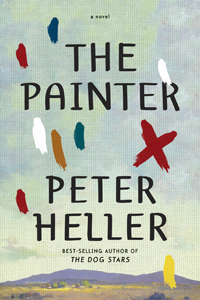Craft, Then Faith, Then Letting Go
With The Painter, acclaimed adventure writer and novelist Peter Heller delivers a soulful page-turner
Jim Stegner, the mercurial narrator of Peter Heller’s The Painter, is a classic rugged American individualist in the long tradition of stoic, soulful, moral but compulsively violent heroes dating back to Owen Wister’s The Virginian and flowing through dozens of incarnations from Zane Grey to Larry McMurtry, Cormac McCarthy, Thomas McGuane, and Jim Harrison. A prominent artist with a blue-collar background and a history of violence, Stegner lives alone in rural Colorado, largely eschewing the trappings of modern technology. (He owns a cellphone only at his Santa Fe art dealer’s insistence.) Between manic bouts of transcendent painting, he spends his days fishing the nearby trout streams, reading the poetry of Rilke and Eliot, and indulging in the occasional roll in the hay with the nubile, ample-breasted, offbeat beauties who are naturally drawn to a larger-than-life Western hero like Stegner.
 Peter Heller is clearly conscious of the territory he’s navigating in making his narrator in the image of such distinctly American icons and iconography. The solitary artist with a salt-and-pepper beard and a fanatical love of fly-fishing is known as “Hemingway” to the locals, and his actual name evokes the august Wallace Stegner, beloved Western novelist and author of more than a dozen works of nonfiction chronicling the settlement of the American West by the descendants of Europeans. Heller, whose prose bursts with tension and terse energy, clearly revels in the challenge of refashioning these archetypes in the form of a brilliant man with a trigger temper and a troubled past who is at peace only when his hands are filled with his paintbrushes, his beloved fly-rod, or the willing body of a woman who is as brilliant and strong as she is beautiful. Indeed, Jim Stegner seems like a good impression of what Jackson Pollock would have been like if he’d returned to the West and traded in booze for an obsession with fly-fishing.
Peter Heller is clearly conscious of the territory he’s navigating in making his narrator in the image of such distinctly American icons and iconography. The solitary artist with a salt-and-pepper beard and a fanatical love of fly-fishing is known as “Hemingway” to the locals, and his actual name evokes the august Wallace Stegner, beloved Western novelist and author of more than a dozen works of nonfiction chronicling the settlement of the American West by the descendants of Europeans. Heller, whose prose bursts with tension and terse energy, clearly revels in the challenge of refashioning these archetypes in the form of a brilliant man with a trigger temper and a troubled past who is at peace only when his hands are filled with his paintbrushes, his beloved fly-rod, or the willing body of a woman who is as brilliant and strong as she is beautiful. Indeed, Jim Stegner seems like a good impression of what Jackson Pollock would have been like if he’d returned to the West and traded in booze for an obsession with fly-fishing.
Nevertheless, as we learn from the novel’s opening sentence—“I never imagined I would shoot a man”—the impulse to violence that looms over Stegner always threatens to disrupt his newfound contentment. It’s also an impulse that provides the plot device whereby The Painter achieves the rare alchemy that makes it simultaneously an intellectually provocative literary novel and a pace-quickening thriller. Vile men regularly cross his path, and Stegner can’t seem to stop himself from picking fights with the vilest of them. He has done time himself and emerged chastened, wary of the world but driven onward by his compulsion to paint, which gives his life meaning and consolation in spite of his missteps and losses—most significantly, that of a teenaged daughter, whose tragic fate is delicately unfolded over the course of the novel.
Stegner’s world is once again set on end when, en route to his new favorite trout-fishing spot, he encounters a man beating a defenseless horse. Reflexively, Stegner assaults the man, who turns out to be Dell Siminoe, a notorious poacher who isn’t the type to take a bloody nose without repaying the gesture with interest. Bad things are guaranteed to follow, and soon Stegner finds himself in another bloody encounter, the outcome of which will threaten both his life and everything he loves.
 From that point on, the novel alternates between adrenaline-fueled fight-and-chase scenes, striking images of the Western landscape, and vivid descriptions of the artistic process and of Stegner’s paintings themselves, which come to life in Heller’s exacting language. Stegner’s ruminations on the practice of fly-fishing evoke Norman Maclean’s classic A River Runs Through It, the bible for those who regard fly-fishing as a form of religious practice. Heller, a who spent the bulk of his career as a freelance adventure writer for magazines like Outside and Men’s Journal, describes mountains and rivers and the mechanics of casting with tangible pleasure. The humming energy and philosophical heft of Stegner’s immersion in the natural world are as compelling as the novel’s taut chase scenes and physical confrontations.
From that point on, the novel alternates between adrenaline-fueled fight-and-chase scenes, striking images of the Western landscape, and vivid descriptions of the artistic process and of Stegner’s paintings themselves, which come to life in Heller’s exacting language. Stegner’s ruminations on the practice of fly-fishing evoke Norman Maclean’s classic A River Runs Through It, the bible for those who regard fly-fishing as a form of religious practice. Heller, a who spent the bulk of his career as a freelance adventure writer for magazines like Outside and Men’s Journal, describes mountains and rivers and the mechanics of casting with tangible pleasure. The humming energy and philosophical heft of Stegner’s immersion in the natural world are as compelling as the novel’s taut chase scenes and physical confrontations.
Similarly, despite the compulsively readable cat-and-mouse drama that ensues from Stegner’s conflict with Dell Siminoe, even the classic-Western elements of The Painter are imbued with penetrating insights. Jim Stegner loathes fighting, but he can’t control his anger and wonders what it says about him that he ends up again and again in the same situations with the same kind of people. To make matters more complicated, he tends to be rewarded for his violent urges. His first real burst of fame as an artist resulted from an incident in which he crushed the fingers of a condescending radio journalist: “They YouTubed and Twittered and the interviewer’s howl went viral. They replayed the scene on the nightly news and I was a sensation and suddenly you couldn’t find a Jim Stegner painting anywhere, couldn’t touch one for less than five figures.” Eventually Stegner is placed in the uncomfortable position of being enriched not merely for his painting but also for his image as a gifted artist who happens to embody what D.H. Lawrence called the essential American soul: “hard, isolate, stoic, and a killer.”
The Painter is as satisfying a read as you are likely to encounter this season. Peter Heller gives you everything you could hope for in a great summer novel: a driving plot with murder, vengeance, and justice; love and love-making between fascinating, attractive people; an insider’s guide to the art world and the lives of famous painters; and an endearing protagonist’s journey toward epiphany and redemption. Heller’s lyrical travelogue of the Southwest will make you want to take up oil painting, book a trip to Gunnison or Santa Fe, and dump a small fortune into fly-fishing gear and instruction, ideally from a rugged guide who can recite Rilke while teaching you to lure rainbows to the end of your line.
More significantly, however, Heller’s novel explores the big themes underlying so much of the literature of the American West: why violence is inevitable, why we admire and are attracted to those who commit it, and why we have become so accustomed to its presence that it ceases to strike us as extraordinary or profane. “We can proceed in our lives just as easily from love to love as from loss to loss,” Jim Stegner claims, but as Peter Heller elegantly argues in The Painter, there will always be both, each flowing from the other, in equal measures.

Ed Tarkington holds a B.A. from Furman University, an M.A. from the University of Virginia, and a Ph.D. from the creative-writing program at Florida State University. His debut novel, Only Love Can Break Your Heart, is forthcoming from Algonquin Books. He lives in Nashville.


